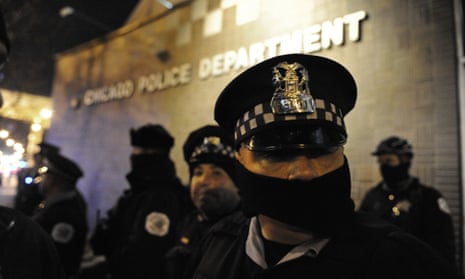Chicago police officer Jason Van Dyke, who has been charged with murder in the 2014 shooting death of a black teenager, had 20 allegations of misconduct filed against him, according to an independent database of police complaints.
The database, created by non-profit journalism group Invisible Institute, includes records of 10 complaints about the use of excessive force by the officer, and other allegations including “improper search of person” and “improper search of vehicle”.
Of the 14 complaints in the database where the outcome of the allegation was known, none resulted in disciplinary action. That fits with a broader pattern revealed by the database – of the 56,361 allegations of misconduct made against Chicago police department officers just 4%, or 2,277, were sustained.
On Tuesday, Van Dyke, a 14-year veteran of the force, was charged with first-degree murder in the killing of Laquan McDonald, 17, on 20 October 2014. Hours later, dashcam footage of the shooting was released, raising tensions in the city.
The database, called the Citizens Police Data Project, was created from Freedom of Information Act (Foia) requests made to the Chicago police department, as part of a more than decade-long collaboration with the University of Chicago Law School’s Mandel Legal Aid Clinic. It’s largely made up of three datasets which cover the period 2002 to 2008 and 2011 to 2015, but continues to be regularly updated in response to individual requests.
Searching for Van Dyke’s name in the database produces records of 20 allegations of misconduct, though details are only available on allegations from 2010 onwards. He joined the force on 25 June 2001.

A separate Foia request made by Ed Nance, who was violently handcuffed by officers during a traffic stop in 2007, showed 15 allegations made against Van Dyke.
For some of the allegations in the database, further detail is available. On 23 January 2013, an allegation was made of verbal abuse that was “racial/ethnic” in nature. The final outcome was “no action taken”. About two months later, on 19 March 2013, an allegation was made by a black male that Van Dyke used excessive force. The allegation, one of 10 complaints about the use of excessive force by the officer, was not sustained and again no action was taken.
Normally, the Guardian would verify the figures in the Invisible Institute database against published records from the Chicago police department. That is difficult, however, given the opacity of official sources which are published without Foia requests. Though incomplete, the database offers a snapshot of complaints against Chicago police.
A summary of the database shows that black individuals are much less likely than white individuals to make successful complaints: black people filed 61% of the complaints in the database, and white people filed 21% of the complaints; but of the complaints that were upheld, only 25% were filed by black people, while 58% were filed by white people.
The police data project highlights “repeat officers” – those with 10 or more complaints made against them – who make up 10% of the force but are responsible for 30% of all complaints in the database.
One such repeat officer is Jerome Finnigan, who had 68 complaints made against him, the highest number in the database, none of which resulted in disciplinary action. Finnigan, a decorated officer, was sentenced to 12 years in prison in 2011 for robberies and other crimes, including ordering a hit on a fellow officer who he believed might expose his corruption.
During a press conference on Tuesday about the fatal shooting of Laquan, the superintendent of Chicago’s police department asserted that the force was showing signs of improvement. Responding to a question from the press, Garry McCarthy said: “Quite frankly, you’re almost forcing me to give you the data on our police shootings over the last four years I’ve been here. They’re down almost 70%. That’s really significant.”
But, among figures for police-involved shootings published by the City of Chicago’s Independent Police Review Authority, the only apparent 70% decline (summarised below), would be to compare the total number of fatal shootings for all of 2010 to those in just Q3 2015.

A review of the reports of each police-involved shooting, 150 in total, published on the review authority’s site since 2010, revealed that 118 involved black males, of which 44 were fatal.
The officers concerned in those cases were often white (we did not extract the race of the officer from each PDF document – in some cases, nine officers were involved). Fifty-five percent of the 13,336 police officers serving in Chicago are white, compared to only 32% of the community they are supposed to represent.
